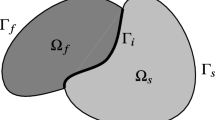Abstract
An implicit partitioned arbitrary Lagrangian– Eulerian approach for fluid-structure interaction computations is considered. Enhancements of the coupled solution procedure by nonlinear multigrid techniques, an adaptive underrelaxation, and proper grid movement techniques are investigated.
Similar content being viewed by others
References
Aitken C (1937) Studies in practical mathematics II. The evaluation of the latent roots and latent vectors of a matrix. R Soc Edinb 57: 269–304
de Boer A, van der Schoot MS, Bijl H (2007) Mesh deformation based on radial basis function interpolation. Comput Struct 85: 784–795
Briggs WL, Henson VE, McCormick S (2000) Multigrid tutorial, 2 nd edn. SIAM, Philadelphia
Demirdžić I, Perić VE (1995) Numerical method for coupled fluid flow, heat transfer and stress analysis using unstructured moving meshes with cells of arbitrary topology. Comput Methods Appl Mech Eng 125: 235–255
Demirdžić I, Perić M (1988) Space conservation law in finite volume calculations of fluid flow. Int J Numer Methods Fluids 8: 1037–1050
Farhat C, Degand C, Koobus B, Lesoinne M (1998) Torsional springs for two-dimensional dynamic unstructured fluid meshes. Comput Methods Appl Mech Eng 163: 231–245
FASTEST (2005) User manual. Department of numerical methods in mechanical engineering, Technische Universität Darmstadt
Heck M, Sternel DC, Schäfer M, Yigit S (2006) Influence of numerical and physical parameters on an implicit partitioned fluid-structure solver. In: European conference on computational fluid dynamics, TU Delft, The Netherlands
Hron J, Turek S (2006) A monolithic FEM/multigrid solver for an ALE formulation of fluid-structure interaction with applications in biomechanics. In: Bungartz HJ, Schäfer M(eds) Fluid–structure interaction. Modelling, simulation, optimization. Lecture notes in computational science and engineering, vol 53. Springer, Berlin, pp 146–170
Hübner B, Walhorn E, Dinkler D (2004) A monolithic approach to fluid-structure interaction using space-time finite elements. Comput Methods Appl Mech Eng 193: 2087–2104
Hughes TJR, Liu WK, Zimmmermann TK (1981) Lagrangian-eulerian finite element formulation for incompressible flow computations. Adv Appl Mech 29: 329–349
Ishihara D, Yoshimura S (2005) A monolithic approach for interaction of incompressible viscous fluid and an elastic body based on fluid pressure poisson equation. Int J Numer Methods Eng 64: 167–203
Löhner R, Cebral JR, Yang C, Baum JD, Mestreau EL, Soto O (2006) Extending the range and applicability of the loose coupling approach for fsi simulation. In: Bungartz HJ, Schäfer M(eds) Fluid-Structure interaction. Modelling, simulation, optimization. Lecture notes in computational science and engineering, vol 53. Springer, Berlin, pp 82–100
Mittal S, Tezduyar TE (1994) Massively parallel finite element computation of incompressible flows involving fluid-body interactions. Comput Methods Appl Mech Eng 112: 253–282
MpCCI (2004) Mesh-based parallel code coupling interface, user guide V2.0. Fraunhofer Institut für Algorithmen und wissenschaftliches Rechnen SCAI, Bonn
Piperno S, Farhat C, Larrouturou B (1995) Partitioned procedures for the transient solution of coupled aeroelastic problems. Part I: Model problem, theory and two-dimensional application. Comput Methods Appl Mech Eng 124: 79–112
Schäfer M, Heck M, Yigit S (2006) An implicit partitioned method for numerical simulation of fluid-structure interaction. In: Bungartz HJ, Schäfer M(eds) Fluid-Structure interaction. Modelling, simulation, optimization. Lecture notes in computational science and engineering, vol 53. Springer, Berlin, pp 171–194
Smith RE (1998) Transfinite interpolation (TFI) generation systems. In: Thompson JF, Soni BK, Wheaterill NP(eds) Handbook of Grid Generation. CRC Press, Boca Raton, pp 3–15
Spekreijse SP (1995) Elliptic grid generation based on laplace equations and algebraic transformations. J Comput Phys 118: 38–61
Stein K, Tezduyar TE, Benney R (2004) Automatic mesh update with the solid-extension mesh moving technique. Comput Methods Appl Mech Eng 193: 2019–2032
Taylor RL (2002) FEAP—a finite element analysis program, user manual. University of California, Berkeley
Taylor RL (2003) FEAP—a finite element analysis program. Version 7.5 Theory Manual. University of California, Berkeley
Tezduyar T, Aliabadi S, Behr M, Johnson A, Mittal S (1993) Parallel finite-element computation of 3d flows. Computer 26: 27–36
Tezduyar TE, Behr M, Liou J (1992) A new strategy for finite element computations involving moving boundaries and interfaces—the deforming-spatial-domain/space-time procedure: I. the concept and the preliminary numerical tests. Comput Methods Appl Mech Eng 94: 339–351
Wall WA, Gerstenberger A, Gamnitzer P, Förster C, Ramm E (2006) Large deformation fluid-structure interaction—advances in ale methods and new fixed grid approaches. In: Bungartz HJ, Schäfer M(eds) Fluid-Structure Interaction. Modelling, simulation, optimization. Lecture notes in computational science and engineering, vol 53. Springer, Berlin, pp 195–232
Wood WL (1990) Practical time-stepping schemes. Clarendon Press, Oxford
Wren GP, Ray SE, Aliabadi SK, Tezduyar TE (1997) Simulation of flow problems with moving mechanical components, fluid- structure interactions and two-fluid interfaces. Int J Numer Methods Fluids 24: 1433–1448
Yigit S, Heck M, Sternel DC, Schäfer M (2007) Efficiency of fluid-structure interaction simulations with adaptive underrelaxation and multigrid acceleration. Int J Multiphys 1(1): 85–99
Yigit S, Heck M, Schäfer M (2008) Grid movement techniques and their influences on laminar fluid-structure interaction computations. J Fluids Struct (accepted)
van Zuijlen AH, Bosscher S, Bijl H (2007) Two level algorithms for partitioned fluid-structure interaction computations. Comput Methods Appl Mech Eng 196: 1458–1470
Author information
Authors and Affiliations
Corresponding author
Rights and permissions
About this article
Cite this article
Sternel, D.C., Schäfer, M., Heck, M. et al. Efficiency and accuracy of fluid-structure interaction simulations using an implicit partitioned approach. Comput Mech 43, 103–113 (2008). https://doi.org/10.1007/s00466-008-0278-y
Received:
Accepted:
Published:
Issue Date:
DOI: https://doi.org/10.1007/s00466-008-0278-y




